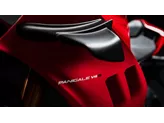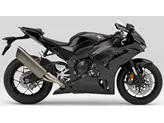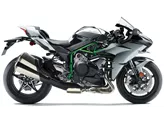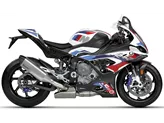Suzuki GSX-R 1000 2010 vs. BMW S 1000 RR 2015

Suzuki GSX-R 1000 2010

BMW S 1000 RR 2015
Overview - Suzuki GSX-R 1000 2010 vs BMW S 1000 RR 2015
In terms of engine and drive train, both the Suzuki GSX-R 1000 2010 and the BMW S 1000 RR 2015 have an inline engine type with 4 cylinders and a displacement of 999ccm. However, there are differences in the bore and stroke measurements. The Suzuki has a bore of 74.5mm and a stroke of 57.3mm, while the BMW has a larger bore of 80mm and a shorter stroke of 49.7mm. This variation in measurements can affect the performance and power delivery of the engines.
In terms of power, the BMW S 1000 RR 2015 takes the lead with 199 HP compared to the Suzuki GSX-R 1000 2010's 185 HP. This difference in power output can result in a more thrilling and exhilarating riding experience on the BMW. However, it is worth noting that the Suzuki still offers a strong engine and appropriate performance.
When it comes to torque, the Suzuki GSX-R 1000 2010 has a higher value of 116.7 Nm compared to the BMW S 1000 RR 2015's 113 Nm. This higher torque value can provide better low-end power and acceleration on the Suzuki.

Suzuki GSX-R 1000 2010
Both bikes have a compression ratio of around 13, indicating efficient combustion and potential for high performance.
In terms of chassis, both bikes have an aluminum frame. However, the Suzuki GSX-R 1000 2010 features a twin-spar frame, while the BMW S 1000 RR 2015 has a twin tube frame. The choice of frame design can affect the bike's handling and stability.
Both bikes have double disk brakes at the front with radial technology, ensuring powerful and effective braking performance.
In terms of dimensions and weights, there are slight differences between the two bikes. The BMW S 1000 RR 2015 has a slightly longer wheelbase of 1425mm compared to the Suzuki GSX-R 1000 2010's 1405mm. The seat height is also slightly higher on the BMW at 815mm compared to the Suzuki's 810mm. Both bikes have the same front and rear tire dimensions, with a width of 120mm and a diameter of 17 inches. They also have the same fuel tank capacity of 17.5 liters.

BMW S 1000 RR 2015
Moving on to strengths, the Suzuki GSX-R 1000 2010 is praised for its strong engine, convincing stability, efficient wind protection, and appropriate performance. On the other hand, the BMW S 1000 RR 2015 is commended for its superb shift assistant, incredibly powerful and rev-happy engine, great range of accessories, and the availability of a race-ready data logging tool and calibration tool.
However, both bikes also have their weaknesses. The Suzuki GSX-R 1000 2010 is criticized for its poor suspension strut, too softly tuned chassis, slight inertia, and a gearbox that could be better. On the other hand, the BMW S 1000 RR 2015's weakness lies in its chassis, which can quickly reach its limit in the hands of professionals.
In conclusion, the Suzuki GSX-R 1000 2010 and the BMW S 1000 RR 2015 are both powerful and capable supersport bikes. While the BMW offers a higher power output and some additional features, the Suzuki still holds its own with a strong engine and appropriate performance. The choice between the two ultimately depends on personal preferences and priorities.
Technical Specifications Suzuki GSX-R 1000 2010 compared to BMW S 1000 RR 2015
Pros and Cons in comparison
Pros and Cons in comparison
Suzuki GSX-R 1000 2010

The engine is a delight to every test pilot with its wonderfully linear power delivery. This characteristic is marred in the hunt for seconds by a too softly tuned chassis.
BMW S 1000 RR 2015

The BMW can still score points with hard facts in 2015. If you like top performance, you have to buy the BMW. It turns out incredibly powerful at the top and drives away the rest of the field from 200. Big and heavy riders will be able to benefit from this even more. BMW didn't make it easy for themselves with this bike and put together a very universal motorbike. If you were to do a comparison test with 50 different riders (from rookie to pro), the BMW would have the best average of all 1000cc bikes. The electronic chassis, but also the riding aids, make the pros fast and the beginners safe on the road. A top recommendation for a very broad target group. Very fast hobby riders will not be 100% satisfied with the standard suspension. If you don't want to modify the chassis, you should rather go for an R1M, a Panigale S or an RSV RF. If you want to convert anyway, the S 1000 RR is the strongest and most universal base. Surprisingly, the powerful machine also rides very well on country roads. All in all, it looks like a compromise, but it never feels like one in practice.
Price Comparison Avarage Market Price Suzuki GSX-R 1000 vs BMW S 1000 RR
There are a few key differences between a Suzuki GSX-R 1000 2010 and a BMW S 1000 RR 2015. It takes less time to sell a Suzuki GSX-R 1000 with 69 days compared to 77 days for a BMW S 1000 RR. Since model year 2005 1000PS.de editors have written 71 reviews for the Suzuki GSX-R 1000 and 135 reviews for the BMW S 1000 RR since model year 2010. The first review for the Suzuki GSX-R 1000 was published on 3/3/2004 and now has more than 7,100 views. This compares to more than 4,000 views for the first review on BMW S 1000 RR published on 4/16/2008.

















